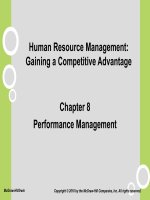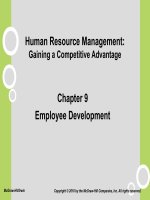HRM gaining a competitive advantage chapter 012 3rd ed
Bạn đang xem bản rút gọn của tài liệu. Xem và tải ngay bản đầy đủ của tài liệu tại đây (313.56 KB, 15 trang )
12
Recognizing Employee
Chapter Contributions with Pay
Objectives
Irwin/McGraw-Hill
• Describe the fundamental pay programs for
recognizing employees’ contributions to the
organization’s success.
• List the advantages and disadvantages of the
pay programs.
• List the major factors to consider in matching
the pay strategy to the organization’s strategy.
• Explain the importance of process issues such
as communication in compensation
management.
• Describe how U.S. pay practices compare with
those of other countries. © The McGraw-Hill Companies, Inc., 2000
How Does Pay Influence
Individuals?
12-2
EquityTheory
Theory-- chapter
chapter 11
11
Equity
ReinforcementTheory
Theory
Reinforcement
ExpectancyTheory
Theory--chapter
chapter 55
Expectancy
AgencyTheory
Theory
Agency
principalsas
asowners
owners
principals
agents as
asmanagers
managers
agents
Irwin/McGraw-Hill
© The McGraw-Hill Companies, Inc., 2000
12-3
Types of Agency Costs
Perquisites
Perquisites
Attitudes toward
toward risk
risk
22 Attitudes
Decision-making horizons
horizons
33 Decision-making
11
Irwin/McGraw-Hill
© The McGraw-Hill Companies, Inc., 2000
Factors in the Choice of a Compensation
Package
12-4
RiskAversion
Aversion
Risk
OutcomeUncertainty
Uncertainty
Outcome
JobProgrammability
Programmability
Job
MeasurableJob
JobOutcome
Outcome
Measurable
Abilityto
to Pay
Pay
Ability
Tradition
Tradition
Irwin/McGraw-Hill
© The McGraw-Hill Companies, Inc., 2000
12-5
Individual Pay Programs: Design Features
Frequency
of Payout
Performance
Measures
- Annually
Profit Sharing
- Bonus
Ownership
- Equity
changes
- Bonus
- Semiannual
or annual
- Sale of
stock
- Monthly /
quarterly
- when skill
is acquired
- Boss’
appraisal
- Output,
productivity
- Profit
- All
Incentive Pay
- Change
in base
- Bonus
- Stock value
- All
- Production
costs
- Skill
acquisition
- Production
/service unit
- All
Programs
Merit Pay
Gainsharing
Skill-based
Irwin/McGraw-Hill
Payment
Method
- Change
in base
- Weekly
Coverage
- Direct
labor
- All
© The McGraw-Hill Companies, Inc., 2000
12-6
Programs
Merit Pay
Incentive Pay
Profit Sharing
Individual Pay Programs: Consequences
Performance
Motivation
- Change
in base
- little
Ownership
- some in
small units
- Little
Gainsharing
- Little
Skill-based
- Learning
Irwin/McGraw-Hill
Attraction
Culture
Costs
- High
performers
- High
performers
- All
- Individual
competition
- Intra-group
competition
- Cooperation
- High
maintenance
- Good system
of appraisal
- Variable
- All
- Knowledge
of business
- Sense of
ownership
- Learning
- Ability to
pay
- Cost not
variable
- can be high
- Retain
employees
- those who
want to
learn
© The McGraw-Hill Companies, Inc., 2000
12-7
Individual Pay Programs: Contingencies
Programs
Merit Pay
Organization
Structure
Management
Style
- Control
Ownership
- Independent
jobs
- Measurable
jobs / units
- Autonomous
units
- Any company
Gainsharing
Skill-based
Incentive Pay
Profit Sharing
Irwin/McGraw-Hill
Type of Work
- Participation
desirable
- Participation
- Individual, easy
to measure
- Individual
appraisal
- All types
- Participation
- All types
- Most companies
- Participation
- All types
- Most companies
- Participation
- Professional
© The McGraw-Hill Companies, Inc., 2000
Merit Pay Programs:
Characteristics
12-8
Triesto
toidentify
identifyindividual
individualperformance
performance
Tries
differences
differences
Supervisor provides
providesmost
mostperformance
performance
Supervisor
information
information
Payis
islinked
linked to
to performance
performance appraisal
appraisal results
results
Pay
Feedbackis
isinfrequent
infrequent
Feedback
Feedbackis
ismostly
mostlyone
one way
way-- supervisor
supervisor to
to
Feedback
subordinate
subordinate
Irwin/McGraw-Hill
© The McGraw-Hill Companies, Inc., 2000
Merit Pay Programs:
Criticisms
12-9
Individualperformance
performance differences
differencesare
aredue
due largely
largely
Individual
to SYSTEM
SYSTEM
to
Discouragesteamwork
teamwork
Discourages
Systemis
isnot
notfair
fair
System
Too much
muchreliance
reliance on
onsupervisor
supervisor for
for rating
rating
Too
proceduralissue
issue
procedural
Payincrease
increase are
arenot
not representative
representative of
of performance
performance
Pay
distributiveissue
issue
distributive
Contributesto
to entitlement
entitlement mentality
mentality
Contributes
Irwin/McGraw-Hill
© The McGraw-Hill Companies, Inc., 2000
Individual Incentives
12-10
Used rarely for the following reasons:
11
22
33
44
55
66
Most jobs
jobshave
haveno
nophysical
physicaloutput
output
Most
Manyadministrative
administrativeproblems
problems
Many
Individualsfocus
focusonly
onlyon
onthe
theincentive
incentive
Individuals
Doesnot
not fit
fitwith
withteam
teamapproach
approach
Does
Doesnot
notreward
rewardobtaining
obtainingmultiple
multipleskills
skills
Does
Rewardsoutput
outputat
atthe
theexpense
expense of
ofquality
qualityor
or
Rewards
service
service
Irwin/McGraw-Hill
© The McGraw-Hill Companies, Inc., 2000
Profit Sharing
12-11
Advantages
Advantages
Encouragesemployees
employeesto
tothink
thinklike
likeOWNERS
OWNERS
Encourages
Paymentsare
arenot
not part
part of
of base
basepay
pay
Payments
Disadvantages
Disadvantages
Manyplans
plansdefer
defer actual
actualpayments
payments
Many
Fewplans
planspay
payout
outduring
duringbusiness
businessdownturns
downturns
Few
Irwin/McGraw-Hill
© The McGraw-Hill Companies, Inc., 2000
Ownership
12-12
Similarto
to profit
profitsharing
sharing with
with employee
employee focus
focuson
on
Similar
organizationalsuccess
success even
evenstronger
stronger
organizational
Employeeownership
ownershipthrough
through stock
stockoptions
options
Employee
Stockoptions
optionstypically
typicallyreserved
reserved for
forexecutives,
executives,
Stock
however,the
the trend
trendis
istoward
towardpushing
pushingpushing
pushing
however,
eligibilityfurther
further down
down in
inthe
the organization.
organization.
eligibility
ESOPs
ESOPs
Irwin/McGraw-Hill
© The McGraw-Hill Companies, Inc., 2000
Gainsharing
12-13
Encouragespursuit
pursuitof
of broader(team)
broader(team) goals
goals
Encourages
Measuresperformance
performance that
thatis
iscontrollable
controllable by
by
Measures
employee
employee
Distributespayouts
payouts frequently
frequently
Distributes
Conditionsfor
forsuccess
successinclude:
include:
Conditions
––
––
––
––
––
––
Irwin/McGraw-Hill
managementcommitment
commitment
management
commitmentto
tocontinuous
continuousimprovement
improvementand
andchange
change
commitment
willingnessto
toaccept
acceptemployee
employeeinput
input
willingness
highlevel
levelof
ofcooperation
cooperationand
andinformation
informationsharing
sharing
high
agreementon
onproductivity
productivity standards
standards
agreement
employmentsecurity
security
employment
© The McGraw-Hill Companies, Inc., 2000
Process and Context Issues
12-14
Employee participation
participation in
in decision
decision
Employee
making
making
Communication
Communication
Pay and
and process:
process: intertwined
intertwined effects
effects
Pay
Irwin/McGraw-Hill
© The McGraw-Hill Companies, Inc., 2000
12-15
Matching Strategy to Operating Strategy
Business Unit Strategy
Defenders
Prospectors
Low
High
Short-term
Long-term
Pay level (short run)
Above market
Below market
Pay level (long run)
Above market
Above market
Benefits Level
Above market
Below market
Centralized
Decentralized
Job
Skills
Pay Strategy Dimension
Risk Sharing (variable pay)
Time Orientation
Where Pay Decision Made
Pay Unit of Analysis
Irwin/McGraw-Hill
© The McGraw-Hill Companies, Inc., 2000









